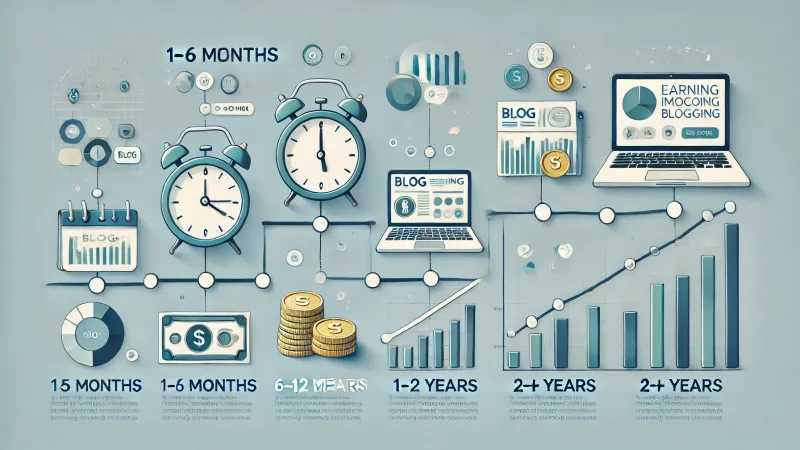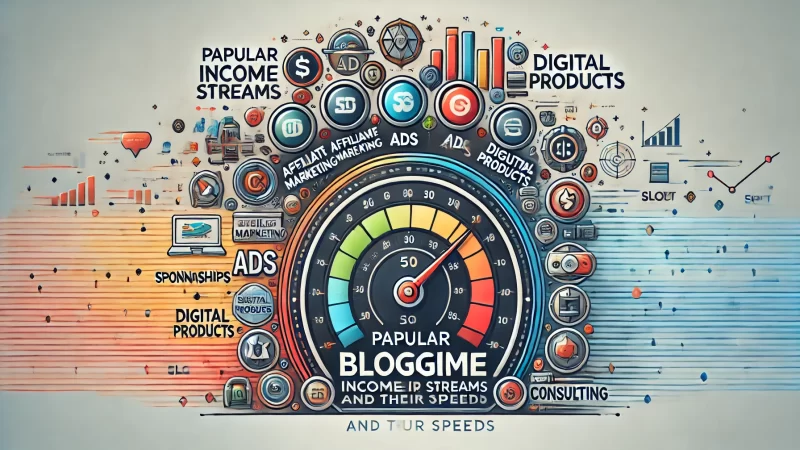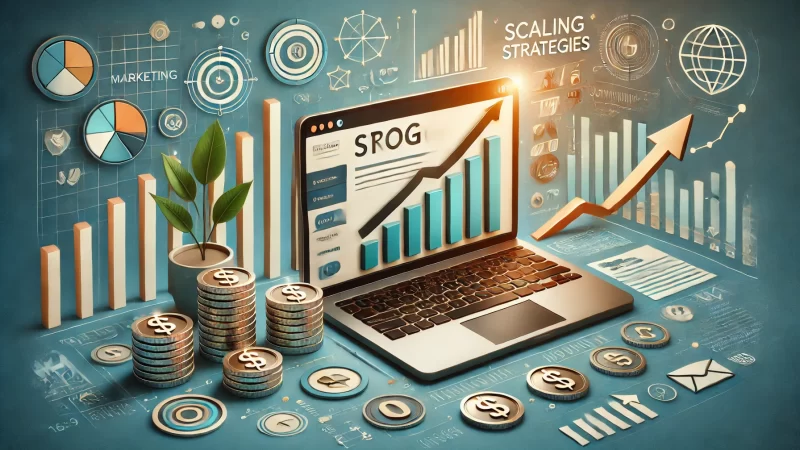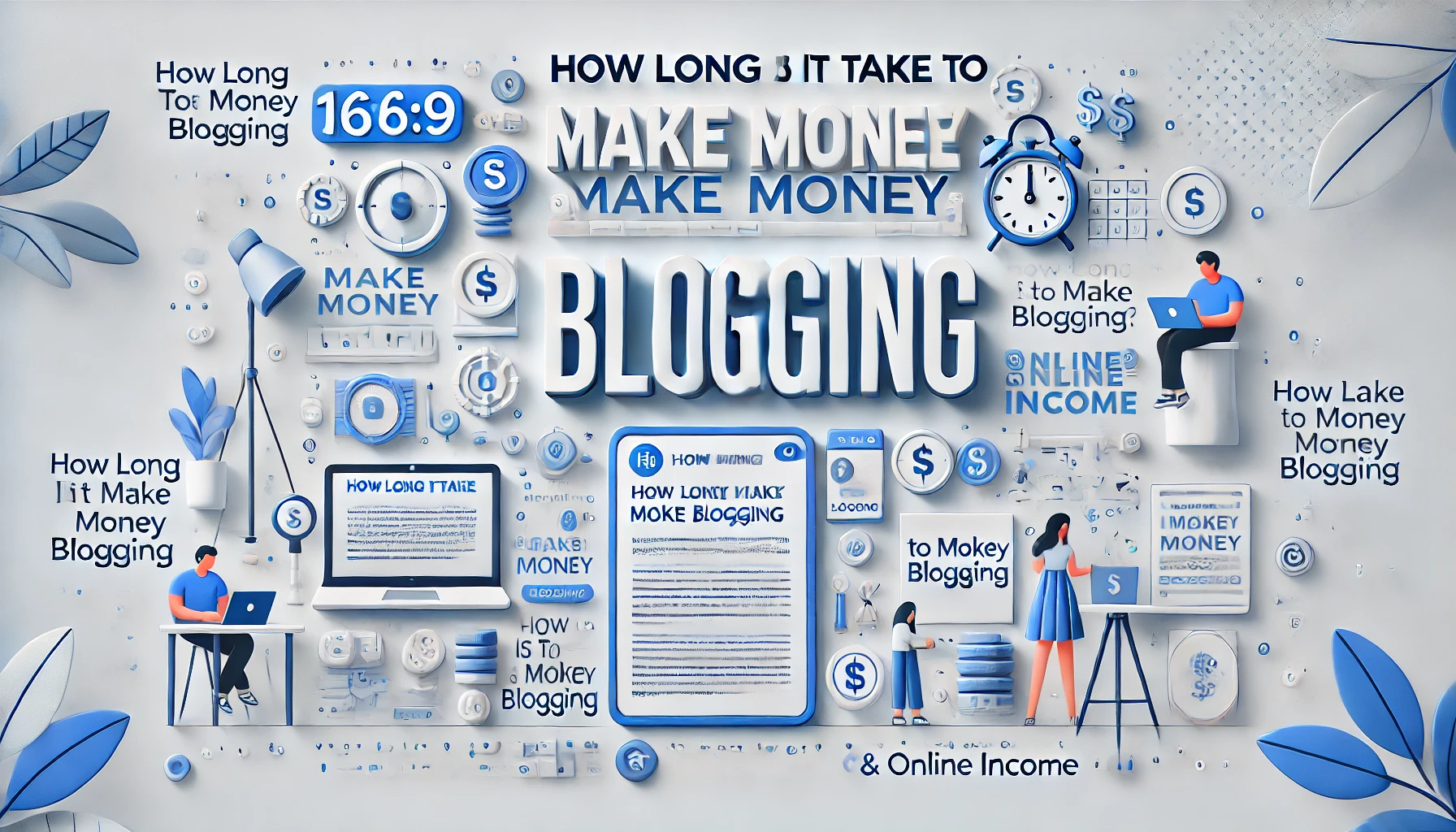Table of Contents
How long does it take to make money blogging? For aspiring bloggers and entrepreneurs, this question looms large. From traffic growth to monetization strategies, understanding the journey to profitability is essential.
In this guide, we’ll uncover realistic timelines, essential tips, and strategic approaches to help you speed up the path to income.
Key Factors That Affect Blogging Income Timelines
Numerous factors determine how long it takes to make money blogging. Each factor, from traffic volume to SEO practices, plays a unique role in a blogger’s earning potential and influences the time required to see income.
Traffic Volume and Consistency
Traffic volume and consistency are critical for generating income through blogging. Higher traffic brings more opportunities for ad revenue, affiliate sales, and product sales, helping bloggers achieve quicker financial results and establish a steady revenue stream.
Consistent traffic builds audience trust, enhancing monetization potential. I recommend focusing on organic traffic sources, like search engines and social media, to create a sustainable traffic base. This strategy helps maintain steady traffic growth over time.
Driving consistent traffic requires targeted content that aligns with audience interests. Publishing blog posts on relevant topics regularly can keep readers engaged. Consistent publishing attracts more visitors, ultimately boosting your earning opportunities.
Keeping a close eye on traffic metrics helps optimize content for better results. Using analytics tools provides insights into what’s working and where improvements are needed. This information is essential for scaling blogging revenue.
Quality of Content and Engagement
Creating high-quality content directly influences income potential. Engaging, valuable content attracts more readers and encourages return visits, which is essential for building a loyal audience and increasing revenue opportunities over time.
Good content sparks engagement, such as comments and social shares. I advise focusing on valuable insights, practical tips, or unique perspectives that encourage readers to interact with your content. High engagement rates improve search rankings and visibility.
When readers engage, they’re more likely to convert. Quality content establishes your authority in the niche, making readers more inclined to support your monetization efforts. This trust is key to enhancing revenue in the long term.
A commitment to content quality also helps with SEO, as search engines reward valuable content. Search engines rank informative, relevant posts higher, driving more organic traffic, which ultimately boosts income potential.
Niche Competition and Market Demand
Your niche significantly impacts how quickly you can earn from blogging. High-demand niches with lower competition offer faster paths to income. I suggest researching niches to identify profitable ones with manageable competition.
Low-competition niches allow for quicker ranking and visibility. When content ranks well, readers can find your blog sooner, enhancing early revenue opportunities. This approach is ideal for those eager to start monetizing quickly.
Higher competition niches can be profitable but require more time and effort to stand out. If you choose a competitive niche, creating unique, targeted content can set you apart. This strategy builds credibility and attracts dedicated readers.
Understanding market demand helps tailor content to audience needs. By focusing on popular topics, you’re more likely to attract readers interested in monetized offerings. I advise aligning content with niche demands to maximize revenue potential.
Monetization Strategy Selection
Choosing the right monetization strategy affects how quickly you see earnings. Some methods, like ads and affiliate marketing, can generate income sooner, while others, like course sales, may require more time to build.
Ad revenue often provides steady, predictable income based on traffic. Affiliate marketing can be lucrative, especially if paired with high-traffic posts. I recommend choosing strategies that align with your blog’s audience and traffic patterns.
Selling digital products or courses may take longer to yield returns but offers high earning potential. These methods require building trust and authority first. Once established, they can become substantial income sources.
Consider experimenting with multiple strategies to diversify income streams. Diversifying helps reduce reliance on one method and enhances overall earning potential, providing more consistent income over time.
Frequency of Blog Posting
Posting frequency directly impacts a blog’s income potential. Frequent updates keep readers engaged and improve SEO, as search engines favor consistently updated sites. I suggest establishing a consistent posting schedule to maximize visibility.
More posts mean more opportunities to target different keywords, driving organic traffic. This strategy improves chances for monetization, as each post attracts new readers. A steady flow of content also builds reader anticipation and loyalty.
Regular posting builds authority in your niche. When readers see consistent, quality updates, they’re more likely to trust your expertise and support your monetized efforts. This trust is key to sustained blogging income.
Tracking post performance helps determine optimal posting frequency. By analyzing reader engagement, you can adjust posting schedules to better meet audience needs, enhancing both traffic and revenue potential.
SEO Optimization and Keyword Targeting
SEO and keyword targeting are essential for attracting organic traffic. Properly optimized content ranks higher, making it easier for readers to find your blog. I advise using relevant keywords naturally to enhance search visibility without stuffing.
Keywords should reflect audience interests. By targeting phrases readers search for, you increase the likelihood of attracting relevant traffic. Higher visibility leads to more engagement and monetization opportunities, boosting income over time.
Using long-tail keywords can improve ranking potential. These specific keywords target a niche audience, improving chances of reaching readers interested in your blog. Tailored SEO strategies drive focused traffic that’s more likely to convert.
Regular SEO updates help maintain and grow traffic. Search algorithms evolve, so staying updated with SEO trends is essential for long-term growth. Continuous optimization keeps your blog competitive and ensures consistent revenue potential.
Typical Time Frames for Earning Blogging Income

Making money from blogging varies depending on the approach, niche, and dedication. Typical time frames offer a realistic perspective, from short-term wins to long-term potential, helping bloggers set expectations for achieving financial success.
Short-Term Expectations (3-6 Months)
In the first few months, many bloggers focus on establishing their niche, building an audience, and creating quality content. Income is often minimal, but it’s a crucial period for setting up the foundation for future earnings.
During this time, traffic may still be low, which limits monetization opportunities. I recommend focusing on content quality and SEO, as these efforts lay the groundwork for organic traffic growth. Patience is essential during this phase.
Some bloggers may see small earnings through affiliate links or ads. However, substantial income usually requires more traffic. Early-stage income should be viewed as a positive indicator rather than a reliable source.
Engagement with readers in the short term helps build a loyal following. Interacting with visitors through comments or social media fosters connection, encouraging readers to return and support monetization efforts in the future.
Medium-Term Expectations (6-12 Months)
After six months, bloggers often experience steady traffic growth and engagement. This period may show increased income potential, especially if consistent content, SEO, and engagement strategies have been in place since the start.
At this stage, affiliate marketing and ads can generate more noticeable earnings. I recommend expanding monetization efforts by exploring other revenue streams like sponsored content or digital products. This diversity increases overall earnings.
Medium-term bloggers should focus on refining SEO tactics. Higher rankings lead to more organic traffic, amplifying income potential. Investing time in SEO during this period can create sustainable long-term growth and profitability.
Experimenting with new content types, like listicles or tutorials, can boost engagement. Varied content keeps the blog fresh, attracting new readers and retaining regular visitors, which is crucial for ongoing income growth.
Long-Term Income Potential (1-2 Years)
Bloggers reaching the one-to-two-year mark often see stable traffic and income. Long-term dedication, combined with strategic content, builds authority, attracting more opportunities for high-earning avenues, like courses or premium memberships.
With higher traffic, ad revenue and affiliate earnings increase. I suggest focusing on high-converting posts, as they tend to generate consistent income. Optimization of top-performing posts can further enhance monetization during this period.
Long-term income allows for more advanced monetization, like selling digital products or consulting services. At this stage, bloggers can leverage expertise for income, providing unique value to readers willing to pay for premium content.
Consistent traffic helps stabilize income, making blogging a reliable source of revenue. Maintaining quality, engaging content while adjusting strategies to market trends supports sustainable growth, ensuring consistent blogging income.
Beyond 2 Years: Scaling and Growth
After two years, bloggers can focus on scaling their income. Established authority enables bloggers to experiment with advanced monetization tactics like high-ticket courses, exclusive content, or brand partnerships for additional revenue.
Scaling may involve hiring assistance or collaborating with other creators. Expanding reach through partnerships amplifies influence and attracts new audiences, further boosting income potential through diversified content efforts.
Consistently updating older posts keeps content relevant. I advise revisiting and enhancing past articles to improve SEO and engage returning readers. This ongoing improvement supports traffic growth, crucial for stable income.
Advanced analytics help fine-tune income strategies. Tracking revenue sources helps identify top performers and optimize accordingly. Strategic adjustments ensure that blogging remains a sustainable and growing source of income over time.
Proven Methods to Accelerate Blogging Earnings
Using proven methods can significantly speed up how long it takes to make money blogging. By mastering essential techniques, bloggers can build momentum faster, enhance income streams, and see the rewards of their hard work sooner.
Mastering SEO for Traffic Growth
SEO is essential for attracting organic traffic, which fuels blogging revenue. Optimizing keywords, creating high-quality content, and improving on-page SEO help rank higher in search results, increasing blog visibility and, ultimately, income opportunities.
Using tools like Google Analytics can reveal which keywords are driving traffic. This insight allows you to focus on effective keywords, maximizing traffic growth and revenue potential. Targeted SEO strategies enhance traffic and help with faster monetization.
SEO involves more than keywords; technical SEO factors like site speed and mobile optimization play a role. Improving these aspects enhances user experience, increases ranking potential, and keeps visitors on the blog longer, which can boost earnings.
I suggest monitoring SEO results regularly to adjust strategies as needed. Algorithm updates can affect blog ranking, so keeping up with changes ensures your blog remains competitive, stable, and profitable in the long run.
Developing a Strong Content Strategy
A well-defined content strategy boosts traffic and engagement, essential for monetization. Knowing your target audience’s interests helps create relevant content that resonates, encouraging return visits and creating more income potential over time.
Planning content around trending topics within your niche can attract new readers. I recommend a mix of evergreen and timely content to provide lasting value while staying relevant. This strategy drives consistent traffic and income.
Frequent posting keeps readers engaged, but quality matters most. Content that solves problems, answers questions, or provides unique insights encourages shares and comments. Engaging readers enhances authority and, over time, leads to higher earnings.
Tracking which posts perform best can guide future content. Insights into popular topics help refine strategy, ensuring each post meets audience needs. A refined approach improves blog performance and speeds up the path to profitability.
Building and Leveraging a Mailing List
Building a mailing list is a powerful tool for engaging readers and driving revenue. It allows bloggers to communicate directly with their audience, promoting products, sharing updates, and increasing opportunities for income.
Segmenting your email list based on reader interests can personalize communication, increasing engagement. Personalized emails are more effective, as readers feel the content is tailored to their needs, which can lead to higher conversions.
Regularly sending valuable content nurtures reader relationships. I suggest a mix of updates, exclusive offers, and helpful tips to keep subscribers engaged. This approach builds loyalty and boosts income from sales or promotions.
Using an email list to promote affiliate links, digital products, or courses can significantly enhance revenue. Email marketing is effective for driving targeted traffic back to the blog, which can further increase blog earnings.
Diversifying Monetization Techniques
Relying on one income source limits revenue potential. Diversifying monetization strategies spreads risk and increases earnings. Using a mix of ads, affiliate marketing, digital products, and services creates more income stability.
Affiliate marketing can complement ad revenue, offering another income stream. I suggest strategically placing affiliate links in relevant posts to boost conversions. Affiliates allow bloggers to earn without product creation, speeding up income.
Creating digital products like ebooks or courses provides long-term earning potential. Digital products sell repeatedly, providing passive income. They also help establish authority, increasing readers’ willingness to invest in your offerings.
Offering services such as consulting or freelance writing through your blog adds another income channel. Services require time investment but often provide high returns, enhancing overall earnings and accelerating blogging income.
Establishing Authority and Trust
Establishing authority encourages readers to support your blog through purchases, affiliate clicks, or other means. Becoming a trusted source within your niche increases reader loyalty and enhances your ability to monetize effectively.
Producing high-quality, informative content establishes credibility. I advise focusing on providing solutions and sharing expert insights that readers value. This approach builds trust, encouraging readers to engage with monetized content.
Engagement through comments, social media, and email strengthens authority. Actively responding to readers shows dedication to your audience, fostering a loyal community that’s more likely to support income-generating content.
Guest blogging on reputable sites expands authority and draws traffic. Sharing expertise on other platforms boosts visibility and brings new readers to your blog, which increases income potential and enhances credibility in your niche.
Popular Blogging Income Streams and Their Speeds

Bloggers have access to multiple income streams, each with varying potential and timelines. Exploring these streams helps bloggers identify which methods align with their goals, maximizing income opportunities based on effort and niche focus.
Affiliate Marketing Potential
Affiliate marketing offers fast income potential once traffic builds. By promoting products or services relevant to your niche, you can earn commissions on sales generated through affiliate links. It’s ideal for bloggers with a dedicated audience.
Choosing quality affiliate programs enhances credibility and boosts conversions. I suggest focusing on products you genuinely endorse, as readers respond better to authentic recommendations. Trustworthy suggestions yield higher earnings and reader loyalty.
Placing affiliate links in high-traffic posts increases exposure. Targeting popular posts for affiliate links boosts conversion chances, enhancing revenue. Monitoring link performance can further optimize placement and income potential.
Promoting affiliates through email lists or social media can drive additional sales. Direct outreach allows for more targeted promotions, increasing conversions and making affiliate marketing a reliable revenue stream over time.
Advertising Revenue Growth
Ads provide a stable income source with consistent traffic. Displaying ads through networks like Hilltopads or Adsterra generates revenue based on page views, making it a reliable option for bloggers focused on traffic growth.
Higher traffic leads to better ad revenue, so content aimed at high-traffic keywords can improve income. I recommend focusing on SEO-rich content to drive organic traffic, which fuels both ads and overall blog earnings.
Ad placement affects revenue potential. Experimenting with ad locations and sizes on your blog can optimize earnings. Testing what works best ensures maximum visibility without compromising reader experience or blog aesthetics.
Balancing ad quantity with content quality maintains user experience. Too many ads can overwhelm readers, reducing engagement. I suggest a strategic balance, ensuring revenue without disrupting the reader’s enjoyment of your content.
Sponsored Content Deals
Sponsored content provides income through partnerships with brands. Working with relevant companies allows bloggers to earn while providing readers with valuable information about trusted products or services in their niche.
Negotiating fair rates for sponsored posts ensures value for your time and effort. I advise being transparent about your rates and aligning with brands that match your values, which builds credibility with readers.
Producing honest, authentic content in sponsored posts builds trust. Readers appreciate transparency in sponsored posts, which strengthens your relationship with them and increases their likelihood of supporting future monetized content.
Promoting sponsored content through your social channels can extend reach. Sharing with a wider audience amplifies brand visibility, increasing the sponsor’s value and boosting your chances of landing more deals in the future.
Selling Digital Products or Courses
Digital products like ebooks or courses offer high-income potential. Creating content that teaches or solves problems attracts readers interested in learning, providing a profitable income source for established bloggers.
I suggest targeting niche-specific topics that align with reader interests for your digital products. This approach ensures relevance, making readers more likely to purchase and enhancing income potential.
Setting up a streamlined sales funnel simplifies the purchase process. An easy checkout experience encourages conversions, increasing product sales. Using clear calls-to-action can guide readers, improving overall product performance.
Promoting digital products through email or blog content drives sales. Consistently reminding readers about these offerings maximizes visibility, turning your blog into a reliable source of passive income through recurring product sales.
Freelance Services Through Blogging
Offering freelance services like writing or consulting diversifies income. Blogging allows freelancers to showcase expertise, attracting clients interested in specific skills or knowledge, making it an effective way to grow a freelance business.
Publishing content related to your services demonstrates expertise, which can attract clients. I suggest highlighting your skills through informative posts, as these establish authority and drive inquiries from potential clients.
Setting up a dedicated services page streamlines inquiries. A clear services page provides details on your offerings, rates, and contact options, making it easier for interested clients to reach out and book your services.
Promoting services through your email list or social channels broadens exposure. Regular reminders of your offerings can attract more clients, enhancing your freelance income while reinforcing your brand within your niche.
Overcoming Common Blogging Income Roadblocks
Challenges often emerge on the path to making money blogging. Identifying and tackling these roadblocks effectively can help you achieve consistent growth and income. Each obstacle, when addressed, brings you closer to your blogging income goals.
Dealing With Low Traffic
Low traffic is a common roadblock for bloggers aiming to monetize. I recommend focusing on high-quality SEO practices, like targeting long-tail keywords and creating valuable content, as these methods can help attract organic, relevant traffic over time.
Using social media to promote blog content can drive new visitors. Engaging on platforms where your target audience is active can broaden your reach, inviting more traffic to your blog. It’s an effective way to build initial readership.
Collaborating with other bloggers can expose your content to wider audiences. Guest blogging, for instance, introduces your blog to new readers, encouraging cross-platform engagement that benefits both parties’ traffic and growth.
Analyzing traffic sources reveals which channels are most effective. I suggest monitoring analytics to optimize focus on high-performing channels. This way, you concentrate on efforts that generate the most traffic, improving your blog’s income potential.
Improving Content Quality and Relevance
Quality content attracts loyal readers, essential for income growth. Content that’s valuable and relevant keeps readers engaged, which I believe is a foundational strategy for building a sustainable and profitable blog.
Researching popular topics within your niche can guide content creation. Posts that address trending issues or provide solutions to common problems are likely to resonate. This approach aligns your content with reader interests, improving engagement.
Improving readability enhances user experience, keeping readers on your blog longer. Short paragraphs, subheadings, and visual aids create a smooth reading flow. Engaged readers are more likely to support monetization, whether through clicks or purchases.
Regularly updating content maintains relevance, especially for SEO. Refreshing posts with current information keeps readers informed and ensures the blog remains a trusted resource, which can positively impact income from loyal visitors.
Addressing Monetization Strategy Errors
Choosing the wrong monetization strategy can hinder income growth. I suggest experimenting with different methods to find what resonates best with your audience, whether it’s ads, affiliate links, or digital products, to maximize income potential.
Evaluating performance data from each monetization strategy can reveal strengths and weaknesses. By identifying what works, you can refine or remove underperforming methods, focusing only on profitable income streams that suit your audience.
Aligning monetization with content enhances conversions. For instance, placing affiliate links within relevant blog posts can improve click-through rates. I recommend integrating monetization naturally into content for a seamless reader experience.
Learning from successful bloggers in your niche can provide insight into effective strategies. Observing their methods may reveal opportunities to optimize your approach, allowing you to make strategic improvements in monetization efforts.
Enhancing User Engagement Metrics
User engagement drives revenue by fostering reader loyalty. High engagement metrics, such as time on page and comments, indicate reader interest, increasing the likelihood that visitors will support monetized content or return to your blog.
Encouraging comments boosts engagement. Asking questions or inviting feedback at the end of posts can create an interactive experience. I advise responding to comments as it builds relationships and shows readers you value their input.
Using social media for discussions related to your blog posts can extend engagement. Hosting Q&A sessions or sharing blog highlights generates interest, drawing readers back to the blog and increasing the chances of conversions.
Enhancing internal linking improves navigation and keeps readers on your site longer. Relevant links within posts guide readers to explore more content, which supports engagement metrics and strengthens your blog’s monetization potential.
Managing SEO and Algorithm Changes
SEO success requires adaptability to algorithm changes. Staying updated with trends and best practices ensures your blog remains competitive, helping to maintain traffic and revenue even as search engine requirements evolve.
Monitoring SEO performance helps track ranking shifts. I suggest using analytics tools to watch for changes that could indicate an algorithm impact, allowing you to make adjustments that support stable visibility and traffic.
Creating high-quality, evergreen content offers SEO stability. Content that remains relevant over time has a better chance of sustaining its ranking, which is crucial for maintaining consistent traffic and income even during algorithm updates.
Regularly refining SEO practices enhances resilience to changes. Small updates, like refreshing keywords or adjusting meta descriptions, can keep content optimized and prepared for shifts, supporting continuous growth for your blog.
Scaling Strategies for Increased Blogging Revenue

Scaling a blog requires strategic growth efforts. These methods focus on expanding reach, improving user experience, and increasing revenue potential, helping bloggers maximize their income opportunities and strengthen their position within their niche.
Expanding Content and Topic Coverage
Broadening your content scope can attract new readers, enhancing revenue potential. I recommend exploring related topics within your niche, as it allows you to capture a wider audience without straying from your blog’s primary focus.
Including trending topics diversifies content and appeals to different interests. Covering relevant trends or industry news draws in new readers, keeping the blog fresh and increasing chances for reader engagement and monetization.
Expanding content also strengthens internal linking opportunities, keeping visitors on your site longer. By linking between related posts, you encourage readers to explore more content, improving engagement and supporting monetization efforts.
Analyzing audience feedback can reveal new content ideas. Readers may suggest topics or ask questions that inspire future posts, ensuring your blog consistently meets their needs and boosts your potential for income growth.
Enhancing User Experience and Site Speed
A smooth user experience encourages readers to stay on your blog. Simple navigation, fast loading times, and a mobile-friendly design are essential. I believe prioritizing these factors makes visitors more likely to engage and return.
Reducing page load times improves user retention. Compressing images and minimizing plugins can help pages load faster, reducing bounce rates. Faster sites provide a better experience, which ultimately benefits both traffic and income.
Ensuring mobile compatibility reaches a broader audience. Many readers access blogs via mobile, so a responsive design is essential. A mobile-friendly site keeps readers engaged, increasing the potential for recurring traffic and revenue.
Clear calls-to-action guide readers through your site. Encouraging actions, like subscribing or clicking links, enhances engagement. I suggest placing CTAs strategically to lead readers toward further engagement with your monetized content.
Creating High-Value, Evergreen Content
Evergreen content retains relevance, attracting consistent traffic over time. Topics that provide lasting value are key, as they continue to drive visitors even months or years after posting, supporting sustained growth and income.
Focus on content that addresses common questions or provides in-depth guides. Readers seek reliable answers, and creating resources they can return to builds loyalty. Engaged, informed readers are more likely to support monetized efforts.
High-value content also attracts backlinks, enhancing SEO. Quality posts are more likely to be referenced by other sites, boosting your blog’s authority. I suggest focusing on informative posts that appeal to both readers and other creators.
Updating evergreen content keeps it relevant and competitive. Regular updates ensure accuracy, which helps retain SEO ranking and reader trust, contributing to a reliable income stream from consistent traffic.
Networking and Collaboration Opportunities
Networking with other bloggers expands reach and fosters growth. Collaborations, such as guest posts or joint projects, expose your blog to new audiences, helping you grow traffic and potential income sources.
Joining niche-specific forums or groups can connect you with like-minded creators. Engaging in these communities builds relationships that lead to collaboration, which can strengthen your blog’s credibility and attract readers.
Collaborative content, like interviews or roundups, provides fresh insights for readers. I recommend featuring industry experts, as it enriches content quality and attracts the expert’s audience, amplifying your blog’s exposure.
Cross-promoting content on social platforms broadens reach. Sharing each other’s posts introduces new readers, helping both bloggers expand their audience and improve engagement, benefiting revenue through increased visibility.
Data-Driven Content Optimization
Data-driven strategies help improve content effectiveness. Analyzing blog performance provides insights into what works, allowing you to refine strategies based on actual results, which is crucial for optimizing both traffic and revenue.
Tracking metrics like bounce rate and time on page reveals engagement levels. Identifying underperforming content offers a chance to enhance quality or relevance, increasing reader satisfaction and monetization potential.
Using A/B testing refines key elements, such as CTAs or headlines. Testing reveals what attracts readers most, helping to maximize engagement and conversions, which directly supports blogging income goals.
Adapting based on audience data ensures your content resonates. Reader behavior often indicates interests, so aligning with preferences improves content appeal and creates a foundation for sustained revenue growth.
Realistic Tips for Consistent Blogging Income Growth
Consistent blogging income requires strategic planning and goal-setting. Following actionable steps supports steady growth, helping bloggers achieve reliable revenue while improving content quality and reader engagement.
Setting Monthly Blogging Goals
Setting monthly goals provides focus and direction. Goals for traffic, engagement, or monetization ensure steady progress, helping you stay motivated and aligned with your long-term blogging income aspirations.
I suggest setting achievable goals that match your current capabilities. For example, aiming for a modest traffic increase is more realistic initially, allowing you to build momentum over time and sustain growth without feeling overwhelmed.
Monitoring goal progress reveals areas for improvement. Evaluating results at month-end shows what worked and where adjustments are needed, helping refine strategies. This continuous refinement supports consistent income growth.
Breaking down larger goals into weekly tasks maintains momentum. Smaller tasks are manageable and keep you on track, building toward monthly achievements and ensuring progress that positively impacts blogging income.
Tracking and Analyzing Blog Metrics
Analyzing metrics provides insight into blog performance, essential for growth. Traffic, engagement, and monetization metrics highlight strengths and weaknesses, helping you refine strategies for optimal income and reader retention.
I recommend using tools like Google Analytics for comprehensive tracking. Detailed insights reveal traffic sources, popular content, and audience behavior, allowing you to make data-informed adjustments to enhance blog performance.
Monitoring conversion metrics shows which monetization methods are working. Knowing which strategies drive income helps focus efforts, maximizing profitability while reducing time spent on ineffective techniques.
Regular metric analysis supports goal alignment. By tracking progress, you can adapt strategies based on what resonates with readers, ensuring the blog grows sustainably and meets income expectations over time.
Investing in Blogging and SEO Tools
Using blogging and SEO tools can improve efficiency and results. Tools for SEO, analytics, or content management streamline tasks, freeing up time and helping bloggers focus on growth-driving activities, such as content creation.
SEO tools enhance content visibility, making it easier for readers to find your blog. I suggest exploring tools that provide keyword insights and competitor analysis, as they reveal valuable information that can elevate your blog’s search rankings.
Content creation tools boost productivity. Resources for brainstorming, editing, or formatting simplify the process, allowing you to focus on delivering quality content consistently, which attracts more readers and revenue over time.
Investing in email marketing platforms supports audience engagement. A well-managed email list is a reliable revenue source, helping nurture relationships and drive readers back to your blog for ongoing support and income potential.
Leveraging Social Media for Traffic
Social media broadens your blog’s reach, driving traffic and engagement. Platforms like Instagram, Twitter, or LinkedIn connect you with audiences interested in your niche, helping attract new visitors who may support monetized content.
Creating content tailored to each platform increases effectiveness. Visual posts work well on Instagram, while Twitter is ideal for short insights. Matching content to platform styles enhances engagement and traffic to your blog.
Encouraging social sharing spreads content further. I suggest adding share buttons to posts to make it easy for readers to share, amplifying visibility and attracting more potential readers and income supporters.
Interacting with followers builds community, encouraging loyalty. Engaged followers are more likely to visit your blog regularly, contributing to a steady traffic stream and supporting consistent blogging income growth.
Maintaining a Steady Blogging Workflow
Consistency is key to growing a blogging income. A steady workflow keeps content fresh, traffic steady, and reader engagement high, helping bloggers achieve reliable revenue while building credibility within their niche.
I recommend setting a realistic content schedule based on your capacity. Posting too often can lead to burnout, while too little content affects engagement. A balanced schedule ensures consistent updates without overwhelming yourself.
Batching content creation tasks can save time. Writing, editing, or researching in batches streamlines the process, making it easier to stick to a schedule and maintain quality, which positively impacts engagement and monetization.
Staying organized with a content calendar ensures workflow consistency. Planning ahead gives a clear roadmap for content, helping maintain momentum and avoiding gaps in posting, essential for sustaining income growth.






